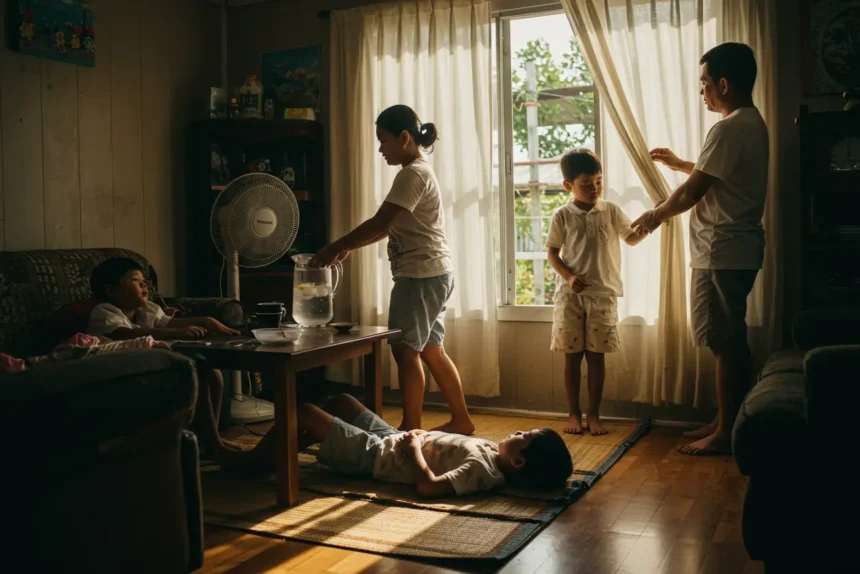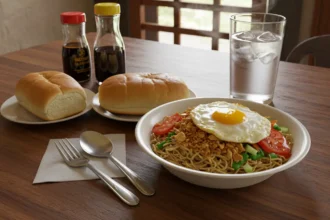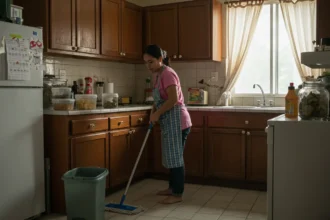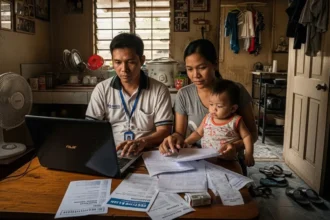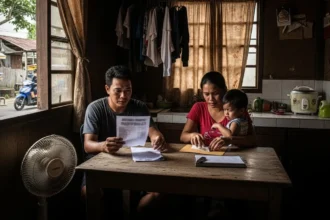If you’ve ever tried to sleep in April without aircon, you know the struggle. The Philippine summer heat can make your bahay feel like an oven – add to that the soaring kuryente bills from Meralco and it’s no wonder many Filipinos are looking for ways to stay cool without breaking the bank.
- 🪟 1. Improve Ventilation
- 🪟 2. Shield Your Windows
- 🏠 3. Insulate the House
- 🌳 4. Go Green (Plants and Trees)
- 🌬️ 5. Optimize Electric Fans
- 💡 6. Swap Out Incandescent Lights
- 🌙 7. Cool Your Space at Night
- 💧 8. Stay Hydrated & Cool Yourself
- ❓ FAQs About Cooling Your Home Without Aircon
- 🏡 Stay Cool, Stay Comfortable
- References:
Not every household has aircon, and even those who do can’t afford to run it 24/7. That’s why simple, low-cost cooling hacks are lifesavers. With the right habits and home adjustments, you can reduce indoor heat, save money, and still feel comfortable kahit tirik ang araw.
| Cooling Method | Avg. Monthly Cost (Est.) | Pros | Cons |
|---|---|---|---|
| Aircon (1 HP, 8 hrs/day) | ₱2,500–₱4,000 | Fast cooling, reliable | High electricity bill, not budget-friendly long term |
| Electric Fan (8 hrs/day) | ₱150–₱300 | Affordable, easy to use, versatile | Doesn’t cool air, just circulates it |
| Natural Hacks (ventilation, curtains, insulation, plants) | ₱0–₱500 (one-time/DIY) | Low or no recurring cost, energy-saving | Results are gradual, not as cold as AC |
💡 Tipid insight: Combining fan use + natural hacks can reduce indoor temp by 2–4°C and save thousands yearly compared to relying on aircon alone.
🪟 1. Improve Ventilation
Good ventilation is one of the most underrated ways to beat the init in a Pinoy home. Airflow doesn’t just make a room feel cooler – it also pushes out trapped heat, reduces humidity, and keeps the space fresh. With the right strategies, you can transform a stuffy sala or bedroom into a breezier, more comfortable space without switching on the aircon.
🔹 How to Improve Airflow at Home
-
Time Your Window Openings
-
Morning & Evening Breeze – Open your windows early in the morning (5–8 AM) or late in the evening (6–10 PM) when outdoor air is coolest. This flushes out heat that built up during the day.
-
Hot Hours Rule – Keep them closed from 10 AM to 3 PM to prevent hot air from entering, especially on east- or west-facing windows.
-
-
Create Cross-Breezes
-
Open windows or doors on opposite sides of the house so air can flow straight through. For example, bintana sa sala + back door sa kusina = instant wind tunnel.
-
If your house has only one major window, improvise with fans. Place an electric fan near the open window facing outward to suck out hot air, while another pulls cooler air in.
-
-
Maximize Exhaust and Ceiling Fans
-
Install an exhaust fan in the kitchen to expel init from cooking. Steam and smoke add unnecessary heat inside the bahay.
-
If you have a ceiling fan, set it to spin counter-clockwise in summer – this pushes cool air downward, creating a stronger breeze.
-
-
Nighttime Airflow Trick
-
Before sleeping, place a fan facing outward at the window to push hot indoor air out. This naturally draws cooler outdoor air inside. For safer setups, use a window screen or kulambo to keep lamok out.
-
-
Clear the Pathways
-
Many Pinoy homes have bulky cabinets or stacks of boxes near windows and doors. But blocked pathways restrict airflow. Rearrange furniture so fans and wind have a straight shot across the room.
-
-
Use Ventilation Boosters
-
For houses with an attic or yero roofing, trapped heat builds up and radiates into rooms. Installing a roof vent or even simple “whirlybird” exhaust helps release this hot air.
-
On a budget? Crack open the ceiling access or add makeshift vent holes to let trapped init escape.
-
🌬️ Why Ventilation Matters in Pinoy Homes
-
Humidity Control – Our tropical climate means high humidity. Good ventilation reduces that sticky, pawis-inducing feeling and makes the heat more tolerable.
-
Safety & Health – Proper airflow prevents mold buildup, especially in bathrooms and kitchens. Less mold = healthier lungs and fewer allergies.
-
Tipid Factor – The cooler your house stays naturally, the less you’ll need to run electric fans or aircon. That’s extra savings on the Meralco bill.
💡 Pro Tip: Cross-ventilation alone can lower a room’s temperature by 2–4°C. In an average Pinoy house with thin walls and metal roofing, that difference can mean a better night’s sleep without switching on aircon.
🪟 2. Shield Your Windows
If ventilation is about letting cool air in, window shielding is about keeping heat out. In the Philippines, direct sunlight can turn your sala or kwarto into a mini greenhouse, lalo na kapag facing east or west ang bintana. The harsh rays not only make the room hotter but also raise your kuryente bill if you’re forced to run fans or aircon longer. Luckily, there are practical hacks to block the init before it even enters your home.
🌞 Simple Ways to Shield Your Windows
-
Curtains That Do More Than Decorate
-
Many Pinoy homes use thin lace or sheer curtains for style, but these barely block heat. Switching to thicker cotton or blackout curtains can cut indoor heat drastically during peak hours.
-
Go for light colors (white, beige, pastel) that reflect heat instead of absorbing it. A white curtain in a bedroom can make it feel cooler by 2–3°C compared to dark fabric.
-
-
Blinds and Roll-Up Shades
-
Bamboo roll-up blinds (kakabit sa labas ng bintana) are common in provinces – mura, effective, and breathable. They block direct sunlight while still letting airflow through.
-
For modern homes, vertical or horizontal blinds let you adjust how much light and heat you want coming in.
-
-
Window Film and Tints
-
Just like car tint, reflective or frosted films bounce sunlight away. A one-time investment of a few hundred pesos per window saves you thousands in electricity over time.
-
Bonus: It also gives privacy without needing thick curtains all day.
-
-
DIY Quick Fixes
-
If you’re on a tight budget, even taping cardboard, banig, or foil on sun-facing windows during noon hours works surprisingly well. Hindi siya Instagram-worthy, pero very effective pang-temporary relief.
-
Some Pinoy households use recycled tarpaulins as makeshift awnings or shade panels.
-
-
Outdoor Shading
-
Extend your window protection with an awning, canopy, or even a simple trapal. By blocking the sun before it hits the glass, you prevent your walls from absorbing heat.
-
If you have a bit of garden space, strategically placed plants (or a trellis with vines) also provide shade and add greenery.
-
🏡 Why Window Shielding Works
-
Reduces Heat Gain – Up to 30% of unwanted heat in a house comes directly through windows. Block it, and your home stays cooler naturally.
-
Saves Energy – Rooms protected with blinds, curtains, or tints need less fan/aircon time, cutting your electric bill.
-
Protects Furniture – Curtains and films also prevent UV rays from fading your sofa, curtains, and wooden furniture.
💡 Pro Tip: Combine curtains (inside) + blinds or roll-up shades (outside) for a double barrier. This layered approach can keep your room noticeably cooler without spending much.
🏠 3. Insulate the House
If windows are the first line of defense, your roof and walls are the next. Most Pinoy houses – especially those with thin GI sheet (yero) roofing – absorb and trap a lot of heat during the day. By 3 PM, para ka nang nasa pugon sa ilalim ng bubong. The good news is, with a few insulation hacks, you can reduce that heat transfer and make your rooms cooler without blasting the aircon.
🔹 Practical Insulation Hacks for Pinoy Homes
-
Under-Roof Heat Barriers
-
Installing an aluminum foil or reflective barrier under your roof prevents heat from radiating into your rooms. Some hardware stores sell “double bubble insulation” rolls – think of it like giant aluminum bubble wrap that reflects sunlight away.
-
Even a DIY version using cartons or plywood sheets in the attic can help reduce direct heat.
-
-
Heat-Reflective Roof Paint
-
Did you know? Painting your roof with white or reflective roof paint can lower indoor temperatures by up to 5°C. White reflects sunlight, while darker paints absorb it.
-
It’s a budget-friendly project – around ₱1,000–₱2,000 worth of paint can cover a small roof.
-
-
Ceiling and Attic Hacks
-
If your bahay has a ceiling, adding a layer of insulation material (like fiberglass mats or foam boards) above it makes a huge difference.
-
For older houses without ceilings, even placing cardboard or plywood panels under the yero helps block some of the heat.
-
-
Wall Insulation and Paint
-
Thick concrete walls hold heat like an oven. Consider painting exterior walls with light-colored paint to reflect heat.
-
For quick fixes, hang large wall curtains, banig, or even plywood panels on interior walls that face the afternoon sun. It’s not fancy, but it reduces radiant heat indoors.
-
-
Vent the Hot Air Out
-
A lot of Pinoy houses trap init sa attic or kisame. Installing roof vents or a whirlybird (rotating roof vent) allows hot air to escape naturally.
-
If you can’t invest yet, just opening the attic hatch in the evening helps release trapped heat.
-
🏡 Why Insulation Matters in the Tropics
-
Heat Reduction – Without insulation, your roof can reach 60°C under direct sun, radiating that heat into your house. With insulation, you cut that by half.
-
Energy Efficiency – A cooler home means less fan/aircon use, saving thousands yearly on electricity.
-
Long-Term Comfort – Insulation upgrades are “one-time investments” that last for years – no daily cost, just lasting comfort.
💡 Pro Tip: Start small. If a full renovation isn’t in your budget, try reflective roof paint first. It’s affordable, quick to apply, and gives instant results in reducing init.
🌳 4. Go Green (Plants and Trees)
Nature is one of the best aircon replacements you’ll ever have. Plants don’t just beautify your bahay – they also reduce heat, add shade, and make the air feel fresher. For many Pinoy households, may tanim sa paso si Nanay or may puno sa bakuran, but with the right placement, these can actually help you beat the heat.
🔹 How to Use Plants for Natural Cooling
-
Plant Shade Trees Near Windows and Walls
-
Trees like mango, narra, or even banana plants provide natural shade, blocking direct sunlight from hitting your walls and windows.
-
If you’re renting, large potted plants (like rubber tree or palms) placed near windows can still provide shade.
-
-
Use Climbing Vines and Trellises
-
Install a simple trellis (kawayan or wire mesh lang) on sun-facing walls and let vines like ampalaya, patola, or even ornamental vines grow. These act as natural shade covers while also giving gulay if edible.
-
-
Add Indoor Plants for Humidity and Freshness
-
Plants like peace lilies, snake plants, or bamboo palms can help regulate humidity and make rooms feel less stuffy.
-
Place them near windows or in corners where air tends to stagnate.
-
-
Green Roofs and Vertical Gardens (Advanced Option)
-
If you own your house, a green roof (grass or plants grown on top of the roof) insulates the house and absorbs heat instead of reflecting it indoors.
-
Vertical gardens along walls facing the sun also help block heat and improve air quality.
-
-
Strategic Placement for Breeze
-
Place plants along pathways where air usually flows (like sa pagitan ng sala at kusina windows). The air passing through greenery feels cooler, like a mini-natural aircon.
-
🌿 Why Going Green Works
-
Shading Effect – Trees and plants block sunlight before it hits your house, keeping walls and roofs cooler.
-
Humidity Boost – Plants release moisture through transpiration, which cools the air around them.
-
Dual Purpose – Some edible plants like kamatis, okra, or pechay not only cool the home but also give food – tipid and sustainable.
💡 Pro Tip: If space is limited, focus on south- and west-facing windows. These get the harshest sun in the afternoon, and shading them with plants can significantly lower indoor heat.
🌬️ 5. Optimize Electric Fans
Electric fans are the hari ng tipid hacks in most Pinoy homes. But did you know there are ways to use them smarter so they feel cooler than usual? Here are some easy tricks you can try right away:
🔹 Smart Fan Hacks for a Cooler Home
-
DIY Air Cooler with Ice
-
Fill a bowl or palanggana with yelo or frozen water bottles.
-
Place it in front of the fan so air passes over the ice, creating a refreshing breeze.
-
Budget tip: Reuse plastic bottles, freeze them overnight, then rotate during the day.
-
-
Fan Positioning by Time of Day
-
Daytime: Point fans inward to circulate air inside the room.
-
Nighttime: Position one fan facing outward at the window to push hot air out, while another circulates cooler night air inside.
-
-
Ceiling Fan Direction Trick
-
If you have a ceiling fan, set it to spin counterclockwise in summer to push cooler air down.
-
Clockwise mode (usually in rainy season) pulls cool air up – not what you need sa tag-init!
-
-
Elevate the Fan
-
Hot air rises. Placing your fan on a higher surface (like a table or shelf) helps circulate the cooler air near the floor.
-
Angle it slightly downward for maximum effect.
-
-
Pair Fans for Cross-Breeze
-
Use two fans: one pushing air inward from a shaded window, the other pushing air outward through another opening.
-
This creates a “wind tunnel” effect, mimicking natural cross-ventilation.
-
-
Clean the Blades Regularly
-
Dust build-up slows down airflow and makes fans less effective. Wipe blades weekly for stronger hangin and better hygiene.
-
🌀 Why These Hacks Work
-
Fans don’t actually cool air, they move it. Smarter positioning and add-ons (like ice) make that airflow feel significantly cooler.
-
Combining multiple fans creates stronger breezes, like a natural wind tunnel inside your bahay.
💡 Pro Tip: A single fan running 8 hours/day costs less than ₱10 in electricity – combine that with these hacks, and you’ll stay cooler while saving thousands compared to using aircon.
💡 6. Swap Out Incandescent Lights
Sometimes the init inside your bahay doesn’t just come from the sun – it’s also from your own appliances. Every time you flip on an old-school incandescent bulb or keep electronics running all day, you’re adding hidden heat to your home. In the Philippine summer, every degree counts, so cutting down these “indoor heat sources” makes a big difference.
🔹 Why Incandescent Bulbs Are Tiny Heaters
-
Did you know that about 90% of the energy from an incandescent bulb turns into heat, not light? That’s why old yellow bulbs feel hot to the touch.
-
Swap them for LED bulbs instead. They stay cool, use up to 80% less electricity, and last 10x longer. LED light + cooler room + lower bill = triple win.
🔹 Electronics That Warm Up Your Home
-
Old TVs and Computers – CRT TVs and desktop CPUs release a surprising amount of heat. If you’re bingeing Netflix all day on an old TV, that init builds up in the room. Flat screens and laptops generate less heat.
-
Kitchen Appliances – Rice cookers, ovens, and stoves naturally release heat while cooking. Simple solution: cook earlier in the morning or evening when the house is cooler, or use small appliances (like air fryers) instead of heating the whole kitchen.
-
Chargers and Small Gadgets – Ever noticed your phone charger or Wi-Fi router feels warm? Multiply that by running them 24/7, and it adds to room heat. Keep them in ventilated spots, not under piles of paper or cloth.
-
Refrigerator Placement – A ref placed near a wall with no airflow works harder, releasing even more heat into your kitchen. Give it breathing space (at least 6 inches behind) so it runs efficiently without overheating the room.
🔹 How to Minimize Appliance Heat
-
Unplug idle gadgets. Even on standby mode, appliances emit both heat and consume “phantom energy.”
-
Group high-heat activities. If you need to iron clothes or bake, do it in the morning or evening when the outside air is cooler.
-
Ventilate cooking areas. Always turn on the exhaust fan or open windows when cooking para hindi ma-trap ang init.
💡 Pro Tip: The less “indoor heat” your home produces, the easier your fans (and wallet) work. Replacing 5 incandescent bulbs with LEDs alone can save ₱300–₱500/month in electricity and make your sala a few degrees cooler.
🌙 7. Cool Your Space at Night
The night should bring relief, pero sa Pilipinas, minsan parang oven pa rin ang kwarto even at midnight. Instead of tossing and turning, try these practical hacks to make your gabi cooler and your tulog more restful.
🔹 Nighttime Cooling Hacks
-
Open Windows for Evening Breeze
-
If safe to do so, open windows once the sun sets to let cooler outside air flow in.
-
Pair it with a fan facing outward to push hot indoor air out, while another circulates cooler air inside.
-
-
Use Breathable Bed Sheets
-
Swap polyester or thick blankets for cotton or linen sheets that allow air circulation.
-
Light-colored fabrics stay cooler than dark ones, which absorb heat.
-
-
Damp Towel or Kumot Trick
-
Hang a slightly damp towel or kumot by the window, or drape it in front of a fan.
-
As the water evaporates, it cools the air – parang DIY aircon effect.
-
-
Chill Your Pillow or Blanket
-
Place pillowcases or small towels in the ref for 10–15 minutes before bedtime.
-
Lay them on your pillow or forehead for an instant cooling boost.
-
-
Sleep Low or on the Floor
-
Heat rises. Sleeping on a lower bed frame or even on a banig on the floor feels cooler than on a high mattress.
-
-
Use Mosquito Nets (Kulambo)
-
A kulambo not only keeps lamok away but also lets you open windows safely for airflow without worrying about bugs.
-
-
Turn Off Heat-Producing Devices
-
Unplug electronics before bed – laptops, TVs, and chargers give off heat even in standby mode.
-
-
Keep a Water Bottle by the Bed
-
Staying hydrated prevents init and discomfort from worsening while you sleep. A sip of malamig na tubig can instantly cool you down.
-
🛏️ Why Nighttime Cooling Matters
-
Cooler sleep = deeper, more restful sleep (mas less puyat).
-
Less tossing and turning means more energy the next day.
-
Simple changes like sheets and airflow tricks cost little to nothing but can improve sleep quality big time.
💡 Pro Tip: Combine open windows, breathable sheets, and a fan on “low” for the ultimate iwas-pawis sleep setup.
💧 8. Stay Hydrated & Cool Yourself
Sometimes, kahit gaano ka pa kaingat sa ventilation or shading, the truth is: Philippine summers are brutal. At the end of the day, part of staying comfortable is cooling your own body, not just the bahay.
Think about it: when you’ve been out commuting in the heat, the first thing you crave is a glass of malamig na tubig or gulaman from the kanto. That instant relief isn’t magic – it’s your body telling you it needs hydration to regulate temperature. Without enough fluids, you’ll feel hotter, more irritable, and more prone to heat exhaustion.
Hydration is your best defense. Keep a reusable water bottle nearby, filled with cold water or calamansi-infused drink. Even sipping small amounts frequently is more effective than gulping a full glass only when you feel nauuhaw. For families, a pitcher of chilled tubig on the table encourages everyone to drink more throughout the day, especially bata at seniors who are more sensitive to init.
Beyond drinking, there are also little diskarte moves to cool yourself:
-
Wear light cotton or linen clothes that breathe. Save the tight jeans and polyester for cooler months.
-
Use cold compresses or ice packs on your pulse points – wrists, neck, or temples – for instant relief.
-
Take maligamgam baths instead of hot showers; lukewarm water helps your body cool down naturally.
-
Enjoy Pinoy classics like buko juice, saging, or fresh fruits that hydrate and energize at the same time.
These may sound simple, pero underestimated sila. A cooler body means you’ll tolerate higher room temperatures better. You don’t always need aircon to feel comfortable – minsan, what your body really needs is hydration + self-care + a mindful break from the init.
💡 Pro Tip: Dehydration can make a 33°C day feel like 38°C to your body. Stay hydrated, and you’ll feel fresher and more alert even in peak summer.
❓ FAQs About Cooling Your Home Without Aircon
Q1: Totoo bang mas tipid ang fan kaysa aircon?
Yes. Fans use around 50–70 watts, while aircon consumes 500–1,500 watts. That’s why using a fan is up to 10x cheaper than running aircon daily.
Q2: Ano ang pinakamabisang low-cost cooling hack?
Combining curtains or blinds with proper fan placement is the most effective. It blocks heat from entering while circulating cooler air inside.
Q3: Puwede bang gamitin ang foil sa bintana para iwas init?
Yes, aluminum foil reflects sunlight and reduces heat gain. It’s a quick DIY fix, though not the most aesthetic solution.
Q4: Bakit mas mainit ang bahay kapag gabi kahit walang araw?
Because your roof and walls absorb heat all day and release it slowly at night. That’s why insulation and ventilation are important.
Q5: Worth it ba bumili ng portable air cooler?
Yes, if you live in a low-humidity area. They’re cheaper to run than aircon, though they’re less effective in humid coastal cities.
Q6: Paano mapapalamig ang kusina habang nagluluto?
Turn on exhaust fans or open nearby windows to let hot air escape. Cooking earlier in the morning or evening also helps avoid adding heat during peak hours.
Q7: Safe bang matulog na naka-open ang bintana?
Yes, if you have secure grills, screens, or kulambo. Always consider safety and insect protection when keeping windows open at night.
Q8: Nakakatulong ba talaga ang plants para lumamig ang bahay?
Yes. Plants provide shade, reduce heat absorption, and add humidity. A shaded wall or window can feel 2–4°C cooler with greenery.
Q9: Ano ang pinakamainit na bahagi ng bahay?
Usually the areas directly under the roof and west-facing rooms. These absorb the most afternoon sun and benefit most from insulation or shading.
Q10: Mas tipid ba magpintura ng puti sa bubong kaysa bumili ng aircon?
Definitely. White or reflective paint lowers roof temperature by several degrees. It’s a one-time cost that saves money every summer, unlike recurring aircon bills.
🏡 Stay Cool, Stay Comfortable
Keeping your home cool without aircon in the Philippines is absolutely doable. By combining small adjustments – like improving ventilation, shading windows, and insulating your roof – with everyday habits such as fan hacks, cooling night routines, and hydration, you can make a real difference in comfort.
You don’t have to do everything at once. Start with the easiest, like swapping out bulbs, hanging curtains, or repositioning your fan. Over time, add insulation, plants, or reflective roof paint if budget allows. Each step adds up, helping you beat the heat while keeping your kuryente bill lower and your family more comfortable.
In our tropical climate, these simple, Filipino-friendly hacks are more than just tips – they’re long-term solutions to living well, tipid, and stress-free kahit walang aircon.
References:
- How to Cool Down a Room Without Air Conditioning – Real Simple
- 10 Ways to Keep Your House Cool without Air-conditioning – Bria PH
- Designing for cooler homes amid the Philippine heat – Inquirer
- Ways to Cool Your House Without Air Conditioning – Esquire Philippines
- A Systematic Review of Passive Cooling Methods in Hot and Humid Regions – MDPI



